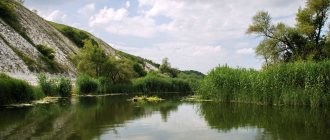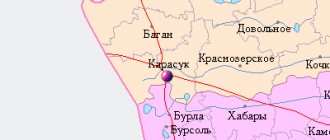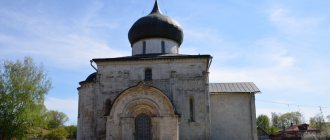In 2012, at a meeting of the regional government, the Head of the Ulyanovsk region, Sergei Morozov, stated that by 2025.
the region's population should be 3 million people. Officials planned to solve the problem of increasing the population, in particular, through the implementation of large investment projects and the creation of new jobs. Experts called the forecast of the Ulyanovsk governor “not even science fiction, but a managerial grin.”
Now Sergei Morozov is no longer a governor. The population of the region is rapidly declining, and in a natural way - extinction. At the same time, the mortality rate is almost 2 times higher than the birth rate. Those. For every one born, two died (Rosstat data).
The outlook for the region is bleak. However, this problem will be solved by the newly elected head of the region, Alexey Russkikh.
see also
- Ulyanovsk region
- Cities of Russia
| [ + ] Cities by regions of Russia | |
| Cities of the North-West (NWFD) | St. Petersburg (and its cities) • Leningrad region (historical Staraya Ladoga) • Arkhangelsk region • Vologda region • Kaliningrad region • Karelia • Komi • Murmansk region • Nenets Autonomous Okrug • Pskov region |
| Cities of the Volga region (Volga Federal District) | Bashkortostan • Volgograd region • Kalmykia • Kirov region • Mari El • Mordovia • Nizhny Novgorod region • Orenburg region • Penza region • Perm region • Samara region • Saratov region • Tatarstan • Udmurtia • Ulyanovsk region • Chuvashia |
| Cities of Southern Russia (SFD) | Sevastopol (including Inkerman) • Republic of Crimea • Adygea • Astrakhan region • Krasnodar region • Rostov region |
| Cities of the North Caucasus (NCFD) | Dagestan • Ingushetia • Kabardino-Balkaria • Karachay-Cherkessia • North Ossetia - Alania • Stavropol Territory • Chechen Republic |
| Cities of the Urals (Ural Federal District) | Kurgan region • Sverdlovsk region • Tyumen region • Khanty-Mansi Autonomous Okrug - Yugra • Chelyabinsk region • Yamalo-Nenets Autonomous Okrug |
| Cities of Siberia (Siberian Federal District) | Altai Republic • Altai Territory • Irkutsk Region • Kemerovo Region • Krasnoyarsk Region • Novgorod Region • Novosibirsk Region • Omsk Region • Tomsk Region • Tyva • Khakassia |
| Cities of the Far East (FEFD) | Amur Region • Buryatia • Jewish Autonomous Region • Trans-Baikal Territory • Kamchatka Territory • Magadan Region • Primorsky Territory • Sakha (Yakutia) • Sakhalin Region • Khabarovsk Territory • Chukotka Autonomous Region |
| see also | Cities of the DPR, LPR, Transnistria, South Ossetia • Regions of Russia • Cities of Russia |
General information about the Ulyanovsk region
Distinctive features . The Ulyanovsk region is officially (at the trademark level) considered the “Aviation Capital of Russia”. Indeed, here is the largest aviation enterprise, Aviastar-SP, which produces Tu-204 passenger aircraft, and is preparing to produce Ruslan transport aircraft. If we talk about mechanical engineering in general, it occupies 15% of the region’s gross structure. In addition to aircraft, the Ulyanovsk region produces world-famous air defense systems (Shilka, Tunguska-M, etc.) and no less famous UAZ SUVs. The nuclear innovation cluster is developed in Dimitrovgrad, the second largest city in the region.
Aircraft production at Avistar-SP. Photo by Andrey Pozdeev
Despite its small area, the Ulyanovsk region has given Russia and the world many celebrities. This is the leader of the revolution Vladimir Ulyanov (Lenin), Russian historian Karamzin, hero of the Patriotic War of 1812, poet, hussar and partisan Denis Davydov, writer Ivan Goncharov... And this is not a complete list! Moreover, the Ulyanovsk region is considered the birthplace of the hero of the Russian fairy tale - Kolobok.
Geographical location . The Ulyanovsk region is located in the center of the middle Volga region. It borders on the Samara, Saratov, Penza regions, as well as the republics of Mordovia, Chuvashia and Tatarstan. The Ulyanovsk region is part of the Volga Federal District.
The main river of the region is the Volga, which passes through the Kuibyshev Reservoir - the largest for this river. The Volga divides the territory of the region into two parts - the Right Bank and the Left Bank. On the right bank there is the Volga Upland, and the left bank (Trans-Volga region) is a lowland. Forests occupy about 25% of the territory of the Ulyanovsk region.
Bridge over the Volga. Photo by Ekaterina Kuleshova (https://fotki.yandex.ru/users/ekaterinacooleshova/)
Population. Once upon a time, the lands of the Ulyanovsk region were part of Volga Bulgaria. Turkic nomads and Finno-Ugric tribes lived here side by side. Now the national composition is as follows: 70% of the population are Russians, and then come the peoples of the Volga region: Tatars (11.59%), Chuvash (7.52%), Mordovians (3%).
Dimitrovgrad - the cultural capital of small nations of Russia
Currently, 1,274,487 people live in the Ulyanovsk region. 74% of them live in cities. Unfortunately, the natural population decline (-2.8 people per 1000 inhabitants) leads to the gradual extinction of the region. Over the past 20 years, the population has been steadily declining. But life expectancy is increasing every year: in 2012 it was 68.5 years.
Crime . The 66th place of the Ulyanovsk region in the ranking of regions by the number of crimes committed eloquently indicates that the criminal situation in the region is calm. Not many criminal offenses are recorded here, but high-profile corruption scandals occasionally appear.
The unemployment rate in the Ulyanovsk region almost exactly coincides with the average for the Russian Federation - 5.57%. The average salary in the region is 16.5 thousand rubles, and the highest salaries are for those involved in the extraction of fuel and energy minerals (34 thousand rubles)
Property value. The average cost of one square meter in Ulyanovsk is 44.5 thousand rubles. According to this indicator, it is comparable to Omsk, Krasnodar or Saratov. Prices for one-room apartments in Ulyanovsk start from 1.4 million rubles. Two-room apartments are much more expensive, around 2 million rubles.
On the streets of Ulyanovsk. Photo by koartemvl (https://fotki.yandex.ru/users/koartemvl/)
The climate of the Ulyanovsk region is temperate continental. The average temperature of the warmest month of July is +21°С, the average temperature of January is −7°С. In winter, Arctic and Atlantic air masses alternate here, so temperature changes are not uncommon. The average annual precipitation is 350-500 mm, depending on the area.
Map
| Ulyanovsk: maps |
Ulyanovsk: photo from space (Google Maps) Ulyanovsk: photo from space (Microsoft Virtual Earth)
| Ulyanovsk Nearest cities. Distances in km. on the map (in brackets along roads) + direction. Using the hyperlink in the distance , you can get the route (information courtesy of the AutoTransInfo website) | |||
| 1 | Isheevka | 15 (19) | NW |
| 2 | Novoulyanovsk | 18 (25) | IN |
| 3 | October | 20 (13) | IN |
| 4 | Attics | 30 (31) | IN |
| 5 | Bolshoye Nagatkino | 34 (40) | NW |
| 6 | Old Maina | 46 (61) | NE |
| 7 | Sengilei | 47 (67) | SE |
| 8 | Maina | 54 (106) | SW |
| 9 | Terenga | 66 (68) | YU |
| 10 | Mullovka | 67 (69) | IN |
| 11 | Staroe Drozhzhanoe (Republic of Tatarstan) | 70 (86) | NW |
| 12 | Buinsk | 72 (94) | WITH |
| 13 | Tetyushi | 74 (99) | NE |
| 14 | Dimitrovgrad | 79 (85) | IN |
| 15 | Bulgarian | 83 (124) | NE |
| 16 | Shemursha (Chuvash Republic - Chuvashia) | 84 (91) | NW |
| 17 | Starotimoshkino | 86 () | SW |
| 18 | Veshkaima | 86 (108) | Z |
| 19 | Karsun | 91 (85) | Z |
| 20 | New Maina | 91 (97) | IN |
| 21 | Batyrevo (Chuvash Republic - Chuvashia) | 96 (111) | NW |
| 22 | Shygyrdan (Chuvash Republic - Chuvashia) | 97 () | NW |
| 23 | Kuzovatovo | 97 (107) | SW |
| 24 | Yalchiki (Chuvash Republic - Chuvashia) | 97 (124) | WITH |
| 25 | Apastovo (Republic of Tatarstan) | 99 (128) | WITH |
| 26 | New Malykla | 101 (109) | IN |
| 27 | Shigony (Samara region) | 105 (165) | YU |
| 28 | Surskoye | 109 (120) | Z |
| 29 | Barysh | 111 (142) | SW |
| 30 | Tolyatti | 111 (184) | SE |
a brief description of
Located on the Volga Upland, on the banks of the Volga (Kuibyshev Reservoir) and Sviyaga rivers, 893 km east of Moscow. River port. Railway junction lines and highways.
The climate is moderate continental. The average temperature in January is -14, July is +20. Precipitation is over 400 mm per year.
Territory (sq. km): 622
Information about the city of Ulyanovsk on the Russian Wikipedia site
Historical sketch
In 1648, during the construction of the Sinbirsk abatis line, the city of Sinbirsk was founded as its starting point. The name of the feature and the city is based on its location in the Sinbir Mountains area, which received its name from the Sinbir settlement (20 km to the south on the left bank of the Volga). Its name is based on the name of the Tatar prince Sinbar from the times of the Golden Horde or the Kazan Khanate. But the use of the suffix -sk allows us to more likely see the formation from a common noun, possibly from an ethnonym.
The fortress was founded on the steep bank of the Volga, called Venets (height more than 120 m), by okolnichy and governor B.M. Khitrovo and clerk G. Kunakov.
In 1670 it was besieged by the troops of Stepan Razin. In 1773 and 1774, Emelyan Pugachev was kept in custody in the Sinbirsky prison.
The name Sinbirsk was used in charters and acts until the end of the 18th century, and in popular usage it remained until the end of the 19th century. From the end of the 18th century. The Simbirsk uniform receives official recognition.
In 1708 it was assigned to the Kazan province, from 1717 - in the Astrakhan province, in 1728 again in the Kazan province, the center of the Sinbir province. Since 1780, the center of the Simbirsk governorship (since 1796 - Simbirsk province).
In the 19th century one of the major centers of trade in bread, fish, livestock, and timber in the Volga region.
In the 1790s. The first public theater was opened in Simbirsk in the 1840s. a theater school was built.
In 1856, in the provincial city of Simbirsk, Simbirsk province, there were 26 churches, 2613 houses, 677 shops.
In 1898 it was connected by railway with Inza, at the beginning of the 20th century. - with Bugulma.
In 1924, it was renamed Ulyanovsk after the name of local native V.I. Ulyanov-Lenin (1870-1924).
Since 1928 it was part of the Middle Volga region (then the region), since 1936 - into the Kuibyshev region. Since 1943, the center of the Ulyanovsk region.
During the Great Patriotic War of 1941-45, a number of industrial enterprises were evacuated to Ulyanovsk.
Municipal indicators
| Index | 1990 | 1999 | 2001 | 2003 | 2005 |
| Demography | |||||
| Number of births, per 1000 population | 14.8 | 7.2 | 8 | 9.1 | 8.8 |
| Number of deaths, per 1000 population | 8.4 | 11.3 | 12.5 | 13.9 | 13.6 |
| Natural increase (decrease), per 1000 population | 6.4 | -4.1 | -4.5 | -4.8 | -4.8 |
| Standard of living of the population and social sphere | |||||
| Average monthly nominal accrued wages, rub. | 0.27 | 1153.9 | 2410 | 4345.8 | 6702.8 |
| Average housing area per inhabitant (at the end of the year), sq.m. | 15.7 | 18.7 | 19.1 | 20.3 | 20.8 |
| Number of preschool institutions, pcs. | 254 | 153 | 140 | 133 | 129 |
| Number of children in preschool institutions, thousand people | 44.4 | 18.2 | 17.4 | 17 | 18.1 |
| Enrollment of children in preschool educational institutions (at the end of the year), as a percentage of the number of children of the corresponding age, % | 60.8 | 59.7 | |||
| Number of daytime educational institutions (at the beginning of the school year), pcs. | 91 | 107 | 108 | 108 | 109 |
| Number of students in daytime educational institutions, thousand people | 85 | 97.3 | 87.6 | 74.8 | 61.7 |
| Number of doctors, people. | 3144 | 3588 | 3540 | 3415 | 3252 |
| Number of nursing staff, people. | 9295 | 11137 | 10784 | 11259 | 10418 |
| Number of hospital institutions, pcs. | 26 | 31 | 30 | 28 | 31 |
| Number of hospital beds, thousand units | 9.3 | 9.8 | 9.2 | 8.7 | 8.4 |
| Number of medical outpatient clinics, pcs. | 48 | 56 | 60 | 62 | 67 |
| Capacity of medical outpatient clinics, visits per shift, thousand units. | 16.6 | 18.2 | 18.4 | 18.3 | 19.6 |
| Number of registered crimes, pcs. | 7403 | 9710 | 10349 | 8380 | 13698 |
| Persons who committed crimes were identified, persons. | 6402 | 5919 | 3891 | 4770 | |
| Economy, industry | |||||
| Number of enterprises and organizations (at the end of the year), pcs. | 10286 | 12338 | 14637 | 17136 | |
| Number of operating enterprises by type of activity: mining (at the end of the year), pcs. | 6 | ||||
| Number of operating enterprises by type of activity: manufacturing (at the end of the year), pcs. | 572 | ||||
| Number of operating enterprises by type of activity production and distribution of electricity, gas and water (at the end of the year), pcs. | 112 | ||||
| Volume of shipped goods of own production by type of mining (in actual prices), million rubles. | 3.5 | ||||
| Volume of shipped goods of own production by type of manufacturing (in actual prices), million rubles. | 34230.3 | ||||
| Volume of shipped goods of own production by type of production and distribution of electricity, gas and water (in actual current prices), million rubles. | 8847.4 | ||||
| Construction | |||||
| Volume of work performed by type of activity “Construction” (until 2004 - volume of work performed under construction contracts), million rubles. | 0.4 | 1790.1 | 2917.4 | 2906.9 | 3594.8 |
| Commissioning of residential buildings, thousand sq.m. of total area | 345.8 | 139.5 | 124.4 | 112.7 | 202.7 |
| Commissioning of residential buildings, apartments | 1963 | 1556 | 1528 | 2652 | |
| Commissioning of preschool institutions, places | 2938 | 0 | 0 | 0 | 0 |
| Commissioning of educational institutions, places | 4322 | 0 | 0 | 0 | 0 |
| Commissioning of hospital facilities, beds | 300 | 0 | 0 | 0 | 0 |
| Commissioning of outpatient clinics, visits per shift | 0 | 30 | 0 | 40 | |
| Transport | |||||
| Number of bus routes (in intracity traffic), pcs. | 58 | 47 | 45 | 28 | 23 |
| Number of tram routes, pcs. | 9 | 17 | 17 | 16 | 14 |
| Length of operational tram tracks (at the end of the year), km | 53.1 | 59.3 | 59.3 | ||
| Number of trolleybus routes, pcs. | 7 | 9 | 9 | 7 | 7 |
| Length of operational trolleybus lines (at the end of the year), km | 26 | 27.3 | 27.3 | ||
| Number of passengers transported by buses per year (in intracity traffic), million people. | 116.5 | 60.1 | 42.5 | 14.2 | 8.3 |
| Number of passengers transported by trams per year, million people. | 122.9 | 178 | 180.4 | 132.1 | 70.8 |
| Number of passengers transported by trolleybuses per year, million people. | 14.9 | 29.2 | 29 | 29.3 | 13.5 |
| Connection | |||||
| Number of telephone sets of the city public telephone network, thousand units. | 79.7 | 130.7 | 146.2 | 200 | 234.4 |
| Number of residential telephone sets of the city public telephone network, thousand units. | 39.9 | 92.6 | 100.8 | 154.7 | 193.9 |
| Number of payphones of the city telephone network (including universal ones), pcs. | 1292 | 1162 | |||
| Trade and services to the population | |||||
| Retail trade turnover (in actual prices), million rubles. | 1 | 7159.8 | 12398 | 21141 | 27784 |
| Retail trade turnover (in actual prices), per capita, rub. | 1.6 | 10342 | 18134 | 32390 | 43317.8 |
| Index of physical volume of retail trade turnover, % compared to the previous year | 110 | 101.4 | |||
| Index of physical volume of public catering turnover, % compared to the previous year | 82.3 | 91.4 | |||
| Number of stores, pavilions (at the end of the year), pcs. | 526 | 532 | |||
| Sales area of shops, pavilions (at the end of the year), sq.m. | 32007.1 | 39610 | |||
| Volume of paid services to the population (in actual prices), million rubles. | 0.186 | 1472.1 | 3409.7 | 6130.5 | 9992.3 |
| Volume of paid services to the population (in actual prices), per capita, rub. | 0.3 | 2126 | 4987 | 9393 | 15579 |
| Volume of household services to the population (in actual prices), million rubles. | 0.043 | 318.9 | 634.4 | 684.1 | 833.9 |
| Volume of household services to the population (in actual prices), per capita, rub. | 0.067 | 460.7 | 928 | 1048 | 1300 |
| Investments | |||||
| Investments in fixed assets (in actual prices), million rubles. | 0.648 | 1141 | 2051.4 | 3925.1 | 4713.4 |
| Share of investments in fixed assets financed from budgetary funds in the total volume of investments, % | 9.6 | 10.9 | 11.9 | 17 | |
Data sources:
- Regions of Russia. Main characteristics of the constituent entities of the Russian Federation: statistical collection. Goskomstat of Russia. - M:, 2003.
- Regions of Russia. Basic socio-economic indicators of cities. Statistical collection. Rosstat. - M:, 2005.
- Transport in Russia: Statistical collection. Goskomstat. - M:, 2003. pp. 110, 112, 120, 122
- Transport in Russia: Statistical collection. Rosstat. - M:, 2005. pp. 117, 119, 127, 129
- Regions of Russia. Basic socio-economic indicators of cities. 2006. Statistical collection. Rosstat. - M:, 2006. p. 255
Culture, science, education
Institutes: pedagogical, polytechnic, agricultural.
Higher Aviation School of Civil Aviation. Branches of Moscow State University and Samara Economic Institute.
Theatres: drama, puppet theaters.
Museums: local history (founded in 1895), art, history of civil aviation.
The poet N.M. was born in the city. Yazykov, writers D.V. Grigorovich, A.I. Goncharov.
Monument to N.M. Karamzin (1845, sculptor S.I. Galberg) - a native of the Simbirsk province. Monuments: “M.A. Ulyanov with his son Volodya”, to Karl Marx (1921), V.I. Lenin (1940), V. Ulyanov - high school student (1954), I.N. Ulyanov (1957), N. Narimanov (1973).
Architecture, sights
Buildings: public places (1807, architect A.D. Zakharov), Assembly of the Nobility (1838-47, architect I.A. Benzeman), Yazykov House (early 19th century), military gymnasium (1877, architect Zalessky) , Public Assembly (1910), Peasant Land Bank (1911, architect F.O. Livchak), house of I.A. Goncharova (1916, architect A.A. Shode), etc.
In the 1960-70s. The central part of Ulyanovsk was reconstructed, where the Lenin Memorial Zone was created (1967-70), including elements of old Simbirsk (mainly houses associated with the life of the Ulyanov family in the city) and the ensemble of the Lenin Memorial Center.
River station (1965), railway station (1970)
| Population by year (thousands of inhabitants) | |||||||
| 1811 | 13.3 | 1956 | 183 | 1992 | 656.4 | 2011 | 614.8 |
| 1840 | 17.7 | 1959 | 205.9 | 1996 | 680.2 | 2012 | 614.4 |
| 1856 | 26.5 | 1962 | 239 | 1998 | 675.6 | 2013 | 615.3 |
| 1863 | 24.9 | 1967 | 294 | 2000 | 667.4 | 2014 | 616.7 |
| 1897 | 41.7 | 1970 | 351.1 | 2001 | 663.6 | 2015 | 619.5 |
| 1913 | 54.7 | 1973 | 395 | 2003 | 635.9 | 2016 | 621.5 |
| 1914 | 55.2 | 1976 | 429 | 2005 | 623.1 | 2017 | 624.5 |
| 1923 | 68.7 | 1979 | 464.0 | 2006 | 617.2 | 2018 | 626.5 |
| 1926 | 70.6 | 1982 | 497 | 2007 | 611.7 | 2019 | 627.9 |
| 1931 | 68.9 | 1986 | 566 | 2008 | 607.0 | 2020 | 627.7 |
| 1939 | 103.8 | 1989 | 625.2 | 2010 | 602.8 | 2021 | 625.5 |
The prospects are sad.
We assessed population decline from 2010 to 2022. Data as of December 31, 2021 have not yet been published.
Over 11 years, the population of the Ulyanovsk region not only increased, as Morozov promised, but, on the contrary, decreased by 70,334 people. Main reason: natural - extinction.
The city of Ulyanovsk has increased its population by 10,244 people over 11 years, which compared to the population in 2022 compared to the population in 2010 is only 1.6%, while the regions of the region have lost 80,578 people over 11 years.
The migration component is also not in favor of the Ulyanovsk region. The indicator is also in the red zone, which indicates population migration from the region. The average statistical data varies around 1.5-2 thousand people per year. However, actual migration is much greater, especially considering that the majority of the working-age population registered in rural areas actually lives outside the region.
We have prepared a rating of districts that are leaders in the anti-rating based on the statistical information we received.
But first
Based on the results of the analysis, the leaders of the anti-rating are:
Starokulatkinsky district (-28.1%), Bazarnosyzgansky district (-22.3%), Veshkaymsky district (-21.8%), Sursky district (-20.1%), Mainsky district (-18.6%)
These five areas have the largest population decline. This fact indicates the negative work of district heads, who are unable to comprehensively address issues of district development, interaction with business, attracting investors, and also work in the interests of residents, thereby dooming districts to extinction. The heads of districts and their teams have clearly been sitting too long and are out of place.
In the middle of the ranking are areas that are also actively losing their population, which also indicates that during the era of “Morozov’s stagnation” the areas simply survive; there is no need to even talk about the development and investment potential of the areas: Nikolaevsky district (-17.6%), Pavlovsky district (-17.5%), Inzensky district (-17.4%), Radischevsky district (-17.0%), Kuzovatovsky district (-16.7%), Karsunsky district (-16.3%), Baryshsky district (-15.8%), Novomalyklinsky district (-15.7%), Melekessky district (-14.9%), the city of Novoulyanovsk (-14.5%), Staromainsky district (-13.1%), Tsilninsky district (-12.7%), Sengileevsky district (-12.6%), Terengulsky district (-12.5%)
the city of Dimitrovgrad (8.3%) and Novospassky district (-8.2%) over 11 years managed to keep the population decline at less than 1% per year,
but the Ulyanovsk district (-1.9%), Cherdaklinsky district (-0.1%) and, of course, the city of Ulyanovsk (+1.6) were able to retain the population. And if everything is clear with Ulyanovsk and the actively developing Port Economic Zone in the Cherdaklinsky district, since the team of ex-Governor Morozov actively invested in the development of these areas, then the third place in terms of population retention in the region - the Ulyanovsk region - really came as a surprise.
Alas, the results for the governor’s new team are dismal. We will take this indicator into account when assessing the actions of the new team of Governor Alexei Russkikh.
The analysis we conducted actually reflects an extremely depressing picture that the Governor’s new team will have to work with, and since the team is again being formed from the “old” new leaders, it is still pointless to talk or assume about forecasts for the region’s recovery from the demographic crisis. Most likely, the dynamics of extinction will continue.








